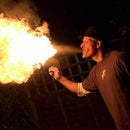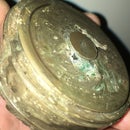Introduction: Making Avocado Ink & How to 'Really' Get Blood Out of a Stone
Mother Nature has some absolute gems of natural beauty & utility hidden away in the environment and human endeavour has always mananged to discover how to harvest and incorporate them into every day use. Obviously this curiously with nature is built in to our DNA and is part of our hunter gatherer make-up. The knowledge and skills acquired were refined and passed down from generation to generation from the very beginning of our emergent species.
Cave Painting - was most probably a ritualistic product of trying to make sense of our surrounds, communicating a thought process, akin to a child trying to make sense of their environment. Thus making pigment one of the oldest tools used for communication. Typically the pigments ranged from red and yellow ochre, hematite, manganese oxide and charcoal. The only things that have changed over time is the complexity and characteristic of the ink make-up and application but the intent is the same, to communicate.
Step 1: Pigment - So Many Sources.
Painting with raw pigments found or made from the environment may have been the starting point in the Stone Age! but so many developments have been made since, recipes and ingredients have literally been lost in time. Many were recorded in archives and many were not, some recipes are still in dispute to this day. It was almost like it was a black art amongst scholars and painters alike.
Water colours are very closely related to cave paint, consisting of a metal oxide and a water soluble binder similar to Gum-Arabic - A closely related paint a cross between gauche & watercolour Is egg tempura, utilising egg yolk as binder. Oil Paint consists of a 'Drying Oil' like linseed or other seed/ nut oils and intimately mixed with a ground pigment, such as an oxide. Other pigments are derived form Herbs, Seeds, Roots & Bark of Plants. Even cocheniel Beetles have been used since antiquity. Some alternative sources are Organic Synthetic Azo Dyes from Crude oil.
Most metal oxides in any of the above applications used by many classic artists through the centuries are toxic and many have been phased out for health reasons. Micas & Tinted clays are mineral pigments used in face and body painting and related to cave painting also.
Ink let's talk about ink - well ink is a bridge between a dye and a pigment used in some paints, like water colour. But from Natural sources and mainly non-toxic. Some plants are very rich in tannins and some tannic acid---like Oak-galls /Acorn Nut/ Horse-Chesnut- Onion Skins - Grape Skins - Black Tea , Red-wood bark,Oak bark and leaves. There are many more sources not listed. These acids can be extracted using an alikali salt such as Sodium /Potassium/ or Calcium Carbonate (for insoluble, See lake pigments).
The main differences with inks and dyes is whether the pigment is soluble or insoluble - insoluble is more a colloidal solution. It can dye as it can have 'Mordant' properties (bites into the surface of cotton). There are so many details I would like to cover- Involving Colour permanence - How light refects and plays an integral part in how certain wave-lengths are reflected and more chemistry.
But I Must Not Digress Any Further - let's make some ink,,!!!!!! --------->>>>>>>
Step 2: Tools & Materials
Goggles nitrile-gloves or any other gloves to prevent staining.
Two stainless steel Sauce pans you can Use one but you will need a (Steel drinks can) ink will eat aluminium.
Knife and Cutting Board
Avocado Pit ,Distilled Water (tap-water is okay)
Hob (low Setting)
Sodium Carbonate (instruction to make it) see proceedure.... Equimolar NaOH & NaHCO3 or Calcination of Baking soda. Image 3 is result after dehydration of both pathways.
Gum Arabic Crystals Pestle & Mortar (or crush between Two spoons)
A brown bottle & Funnel
Two Spoons.
Step 3: Tools and Materials Necessary & Proceedure
If you want to make a small amount of ink you just need (1) Fresh Avocado Pit. Drop into hot water for a few mins - the outer brown skin will blister and aid the peeling of the pit. The pit is a seed, so it is easy to part into two pieces. Now chop each half into little bits like you would finely chop an onion. Take a small saucepan (Stainless Steel Only) and fill with 200ml of hot water, the 200ml needs to be maintained throughout the process. You may see a light orangy colour in the water, similar to when preparing potatoes. Put onto a low Setting a little simmer only.
Now add (1 tsp of Sodium Carbonate) sodium Carbonate can be made two ways ----- calcination of baking soda (Strongly Heating in oven) or my way for quick use. Weigh out equimolar amounts of NaOH & NaHCO3 - place 2gms of Hydroxide and 4.3 gms Baking Soda (bicarbonate) in enough water to dissolve them - use cold water and put hydroxide in first, then put baking soda in. When dissolved add to the pot.
An amazing transformation should now be now witnessed. First a Light Green & Then Slowly a Pink and After A little while a Blood Red, like in the picture above. The cooking process is relatively short 25-30 mins. If you have a deep Blood Red by now then decant liquid into another vessel to separate pit material. Add a small amount of water to the material to wash/ extract more dye, then discard pit. Add the wash to other pan to increase ink volume slightly.
Now we need to prepare a fixing additive . Take a level teaspoon of Arabic-Gum crystals and grind into powder using pestle & mortar. Or between two spoons, add this to the ink and dissolve. Now we are ready cover pan and leave to settle and cool - decant into a tightly fitting brown bottle. When decanting take care not to spill liquid as it's very messy and disregard any sediment which may be in the bottom of the pan.
Now use at your leisure ////Brush painting - Pen and Ink - Dip Pen or even Nib-pen it is really good ink!!!!!!
Please rate and comment :-)













